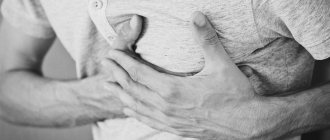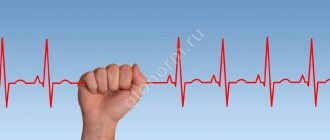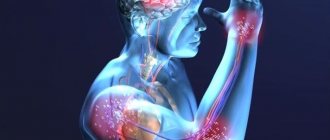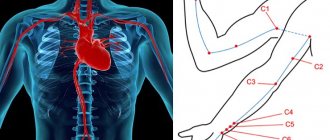The main reasons for the progression of the disease under study
If collapse occurs, emergency care is indicated in the following situations:
- acute bleeding, resulting in the loss of a large amount of blood,
- serious burns,
- viral diseases,
- intoxication with certain medications,
- stressful situations; depressive mood
- acute cardiovascular failure,
- diseases in the nervous system,
- endocrine pathology.
First aid for emergency conditions of the cardiovascular system
Friday, May 17, 2019
Fainting is a brief loss of consciousness. When wondering how to provide first aid for fainting, you need to understand that such a problem is not independent, but only represents one of the signs of various disorders or malfunctions in the body. In the event that fainting occurs once, it can be attributed to excessive emotional stress or nervous shock. However, if a person loses consciousness quite often, there are definitely reasons for this, among which are the following:
- A decrease in blood pressure, provoked by both external factors and a variety of ailments.
- Violation of the full regulation of the cardiovascular system, accompanied by the outflow of blood from the brain. This manifestation is often associated with too much physical exertion or occurs due to a sudden change in body position.
- As a result of prolonged exposure to the rays of the scorching sun, heat stroke can occur, which can lead to fainting.
- Severe food and alcohol intoxication or pharmaceutical poisoning.
Just before losing consciousness, most people notice previous symptoms. Therefore, if the following phenomena occur, you should immediately help the person take a horizontal position.
· feeling of numbness in the upper and lower extremities;
· pallor of the skin;
· the appearance of ripples or “flies” before the eyes;
· cold sweat accompanied by icy feet and palms;
· nausea, vomiting;
Ringing, noise or feeling of stuffiness in the ears;
· severe weakness, in which the legs may give way.
A distinctive feature of fainting is a rapid heartbeat, accompanied by perspiration and redness of the skin.
Providing first aid for fainting and the above-described signs of an impending fainting condition requires not only a clear algorithm of actions, but also a number of certain things that are strongly not recommended to be done.
In particular, a person who is losing consciousness should not be sharply braked or shaken, which is often attempted by incompetent assistants. It is also prohibited to move the patient and force him into a sitting or upright position.
First aid
- The person needs to be helped to take a lying position and free him from compressive elements (loosen the belt, tie, unfasten the collar).
- If you have ammonia on hand (10% aqueous solution of ammonia), moisten a cotton swab with it and bring it to the victim’s nose, but not closer than 4-5 cm (ammonia vapor has a powerful stimulating effect on the breathing center
- The head moves slightly to the side so that the unconscious person does not choke on vomit.
- You need to open the windows to provide oxygen. If collapse occurs due to overheating in the sun, the patient must be immediately moved to the shade.
- The patient's lower limbs should be kept in an elevated position, which will provide additional oxygen flow to the brain.
Angina pectoris is a clinical syndrome characterized by a sensation or feeling of discomfort behind the sternum, occurs with coronary heart disease as a result of coronary insufficiency due to a decrease in the lumen of the cardiac artery.
During an attack of angina, there is a feeling of tightness or heaviness in the chest, pain radiates to the left side of the arm, shoulder or jaw. The person sweats a lot and has a feeling of fear.
Attacks of angina pectoris occur against the background of physical activity or strong emotional experience, which is relieved at rest. This is where exertional angina occurs. An attack can also occur at rest, that is, after sleep in the morning or at night. This is angina at rest.
First aid for angina pectoris.
- First of all, ease your breathing by unbuttoning the first buttons on your clothes, loosening the waistband of your trousers and skirts.
- If possible, place the patient in a semi-recumbent position. In this position, the heart's need for oxygen decreases and the attack quickly passes.
- Immediately place nitroglycerin under your tongue for immediate relief.
- If there are no medications, to relieve a painful attack, you can put mustard plasters on the area of the heart or chest (where the pain is felt).
- A hot mustard bath for your hands is also suitable. Take one tablespoon of dry mustard and dilute it in one liter of hot water. It will be enough to hold your hands in it for 5-7 minutes. Or immerse your hands in clean hot water for the same amount of time.
- Explain to the patient the correct breathing technique: it is better to breathe through the nose, slowly and deeply, holding at the height of inspiration and at the same time maximally protruding the upper abdomen. With this type of breathing, the air pressure in the chest decreases, which facilitates the flow of venous blood to the heart. Slow breathing allows the body to accumulate carbon dioxide, which leads to dilation of the blood vessels of the heart, which improves the supply of oxygen to the heart muscle.
Myocardial infarction is one of the clinical forms of coronary heart disease (CHD), which occurs with the development of ischemic necrosis (local tissue death) of a section of the myocardium (the muscular middle layer of the heart, constituting the bulk of its mass), due to the absolute or relative insufficiency of its blood supply.
Signs of myocardial infarction are:
- Very strong squeezing pain behind the sternum. It is not relieved by taking nitroglycerin. May radiate (give) to the left half of the chest, left arm or shoulder blade. Duration - from 20-30 minutes to several hours.
- Cold sweat.
- Dyspnea.
- Frequent and irregular pulse.
- The person suddenly turns pale and complains of fear of imminent death and lack of air.
- The patient is excited.
- Nausea, sometimes vomiting.
First aid:
- Provide the patient with complete rest and fresh air.
- Give nitroglycerin, warn that it must be completely absorbed. Give the next tablet after 5 minutes. Repeat no more than 3 times. If nitroglycerin is not available, give validol. It is necessary to measure blood pressure, because... it may drop sharply. If this happens, nitroglycerin and validol should not be given.
- Be sure to call an ambulance.
- To calm the patient, drop 30-40 drops of Valocordin or Corvalol onto a piece of sugar and let it dissolve.
- Give 1 tablet of aspirin (to reduce the process of thrombosis). The tablet must be chewed and washed down with water. You can give 2 tablets of analgin to reduce pain.
- Place mustard plasters on the calf muscles of the limbs as a distraction.
- If clinical death develops, begin chest compressions.
How does collapse occur?
The progression of the disease is quite acute. The condition is dangerous, and in the absence of timely emergency assistance in case of collapse, we can talk about serious and terrible consequences.
The main symptoms of the disease are:
- general weakness of the body and fatigue,
- dizziness,
- decrease in blood pressure,
- the skin becomes significantly lighter,
- decrease in temperature indicators,
- chills,
- facial features become sharper,
- dry mouth,
- loss of consciousness.
Help with collapse is urgently needed!
Types of collapse
Depending on its pathogenesis, collapse occurs:
- traumatic – provoked by severe injuries;
- hemorrhagic - appears after significant blood loss;
- burn - begins after receiving third or fourth degree burns;
- anaphylactic – caused by a severe allergic reaction;
- infectious – occurs at the peak of development of an infectious disease;
- hemolytic – caused by incompatibility of blood during transfusion;
- orthostatic - is the result of a sharp bringing of the body into a vertical position;
- hypovolemic – characterized by a decrease in blood volume in the vessels;
- cardiogenic – occurs due to damage to the heart muscle;
- vascular – associated with a decrease in the elasticity and strength of blood vessels;
- mixed – combines several reasons.
Symptoms of collapse
It is not possible to confuse collapse with another disease, since its signs are usually very clear:
- paleness or cyanosis;
- sallow complexion;
- sharp facial features;
- weakness, up to loss of consciousness;
- severe headache and dizziness;
- pronounced rapid heartbeat;
- noise in ears;
- feeling of cold and fear;
- decrease in temperature and pressure;
- the appearance of sticky sweat;
- blurred vision;
- pupil dilation.
Symptoms
The disease occurs completely unexpectedly. Initially, weakness and dizziness occur, and the patient is thirsty. The skin becomes lighter than its normal state, profuse cold sweating appears on it, characterized by chills. The pulse becomes slower, the pressure decreases significantly, and shortness of breath is also observed. Among other things, you may notice deterioration in vision, the appearance of extraneous sounds in the ears, and the person may be worried about something. As the disease progresses, a person's thoughts become confused, his pupils dilate, and his heart beats much faster.
symptoms of collapse
Causes of fainting
- Fright, unexpected severe sharp pain, nervous shock. Because of them, a sharp decrease in blood pressure can occur, resulting in a decrease in blood flow, a disruption in the blood supply to the brain, which leads to fainting.
- Weakness of the body, especially if it is accompanied by nervous exhaustion. General weakness of the body, which can occur due to hunger, poor nutrition or constant anxiety, can cause low blood pressure and fainting.
- Staying in a room with a small amount of oxygen. A lack of oxygen can occur due to poor ventilation if the room is very smoky or there are a lot of people in it. In such a situation, the brain does not receive the required amount of oxygen, as a result of which fainting occurs.
- If you stand for a long time without moving. Lack of movement leads to stagnation of blood in the legs and reduces its flow to the brain. The result is fainting.
Prevention and treatment
If you are wondering what is the sequence of first aid for collapse , then we offer you the following recommendations:
- The pathology in question implies a phenomenon that requires immediate intervention by specialists. People who happen to be nearby when the disease progresses should change the position of the patient during collapse and put him on the bed, raise his legs and cover him with a warm blanket to prevent him from freezing.
- In a short period of time, you need to find the cause of the decrease in pressure and get rid of it: stop heavy bleeding, give the person the necessary medications, and so on.
- At this time, it is also necessary to provide for parenteral infusion of blood components or mixtures that serve as a replacement for blood.
- In some particularly dangerous situations, it is necessary to carry out resuscitation measures to help save the patient’s life.
Prevention of this disease is reflected in properly selected treatment of those pathologies that can cause the development of collapse, in systematically undergoing a medical examination and taking into account the side effects of medications taken. Now you know the difference between collapse and fainting , and how to provide first aid.
Emergency care for collapse
To successfully relieve the syndrome, the following algorithm was developed:
- Call an ambulance.
- Place the victim on a hard surface (table, asphalt road) and raise his legs using a cushion of clothing (this will increase blood flow to the heart and brain).
- Unbutton the collar of a tight-fitting shirt/blouse to facilitate breathing.
- Open the windows and door to ventilate the room.
- Since during collapse there is a decrease in body temperature, it is very important to warm the patient. If he is conscious, give him hot tea or coffee to drink; if not, wrap it in a warm blanket and put a heating pad on it.
- Wet a cotton swab with ammonia and bring it to the nose, rub the patient’s temples and earlobes.
- If possible, administer a solution of adrenaline and ephedrine.
NotaBene! In a collaptoid state, it is strictly prohibited:
- bring the patient to his senses by patting the cheeks;
- place a pill in the victim’s mouth or pour water into it if he is unconscious;
- giving heart medications - the popular nitroglycerin or validol, on the contrary, dilates blood vessels.
Causes of collapse
The causes of collapse can be very different - from past illnesses to age-related characteristics.
Causes of cardiovascular collapse:
- Large loss of blood, which may be the result of a rupture of an internal organ or serious external injuries to the body.
- Sudden change in body position while lying down
patient.
- Various past infections
diseases.
- Intoxication of the body (for example, an overdose of various drugs or food poisoning).
- Heart rhythm disturbances.
- Dehydration of the body.
- Severe electric shock.
- High ambient temperature.
- Strong doses of ionizing radiation.
| When providing medical care, it is necessary to correctly determine the cause that caused the collapse and direct all efforts to eliminate this factor. |
Providing first aid for fainting
- If the victim’s breathing is fine (the airways are clear, the pulse is palpable), you need to put him in a stable lateral position with his legs raised and his head bowed;
- When providing first aid, unfasten the victim’s constricting parts of clothing, such as a collar or belt, to provide access to fresh air;
- Splash your face with cold water. This will narrow the blood vessels and improve blood supply to the brain;
- Pat your cheeks, rub your chest and stomach;
- If the victim does not regain consciousness within a few minutes, most likely it is not fainting, and he needs medical help;
- Allow to inhale vapors of ammonia to stimulate the respiratory center;
- Monitor pulse, breathing, pupil size;
- If possible, give the victim who has regained consciousness some hot tea. After this, help him get up and sit down. There is no need to rush and immediately get him to his feet. If the person who wakes up after fainting experiences a faint state, lay him down again with his legs elevated.
- Do not forget that fainting can be a sign of a serious illness, and the victim needs a qualified medical examination.
– acute vascular insufficiency, in which the mass of blood circulating in the body decreases significantly and the overall vascular tone decreases.
Cardiac collapse can often lead to death, which is why it is so important to provide first aid during its attacks. Such dire consequences are due to the fact that the brain ceases to receive sufficient amounts of oxygen, which are delivered to it through the blood circulation.







